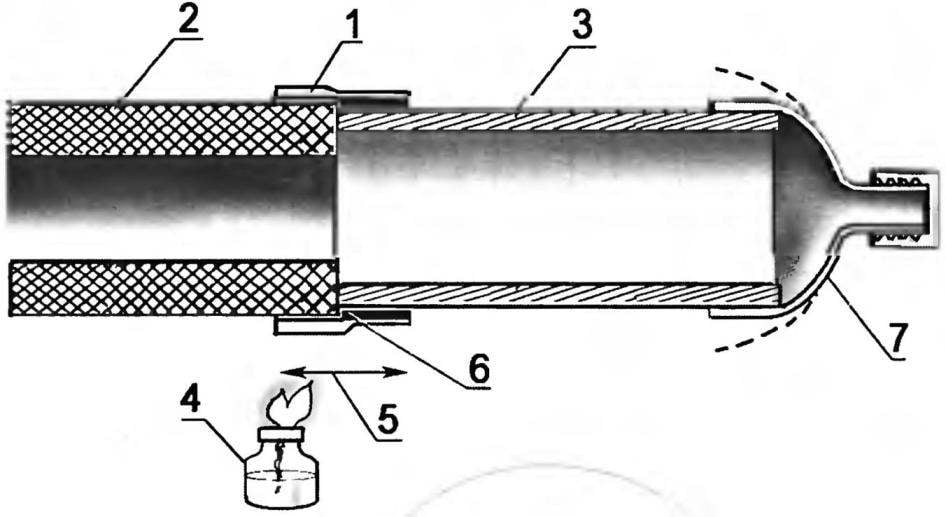You can shrink secure the hook on the vertical cylinder and hung on a hook anything (Fig. 8): ugly, but firmly, quickly. It is possible to capsize, to interconnect a few bottles or to attach a Widener bottom to the container at the bedside of the sick, that he accidentally knocked over (Fig. 9). You can connect the bonding part to the curing of the adhesive. If the glue is soluble and hardens by drying of the solvent, to dry it will be 1.5 — 2 times longer and it is possible that deeper absorbed. These options — only the common household works.
The second of the two proposed technologies use the material of plastic bottles, for example, as a solder for soldering (welding) plastics as a hot-melt adhesive or putty.
With melt’s simple: the thinner the layer and the greater its area, the stronger. After a certain value of the square becomes important volumetric stiffness of the attached Products. Glue is applied in small droplets, followed by heating the product with glue, and clamp to the surface (strong, but so that not a drop of glue together in a single field). Remains allow to cool and use the product.
Another example: in the bathroom or in the kitchen to make the hooks for towels, appliances, etc. Usually had to spoil the tile (or drilling durable concrete), which is not very desirable. Come to the rescue of the melt bottles, drops and hang a beautiful hook (Fig. 11). Simple rule: better ten hooks smaller than four major. The more load on one suspension, the harder it is to make reliable, and it is larger than the more spoils the appearance.
Caveat: for brittle materials it is necessary to glue very quickly. On the window glass, for example, cooling should begin within 3 to 4 seconds after the first contact of the molten glass and “glue” — otherwise the glass will burst.
Fig. 9. Holder:
1—CD-Widener bottom; 2—capacity, which is necessary to give stability; 3 —resistant petals to the receptacle; 4—o-ring (from the bottle, after the shrinking)
Fig. 10. Insulator:
1 —the abutting pipe (or wire); 2—clamp (coupling); 3—wide ring from the bottle after shrinking
Fig. 11. Hooks for the bathroom:
1—tile (or other surface that you do not want to drill); 2—zone “glue”; 3 hooks for hanging products
Fig. 12. Repair items:
1 —heel; 2—furniture leg; 3—extended instead of lost a layer of melt bottles
The material is very easy to machining after cooling of the melt and easily shaped when heated. If you need to putty anything (Fig. 12) — cut in strips from the bottle with a width of 1 — 5 mm of required length, with the left hand strip served on the hot soldering tip held by the right hand as close as possible to the place of adhesion of the adhesive. Periodically tip works like a spatula, pushed a lot of polyester in shpaklyuem plot or levelling the surface. When the whole volume is bonded to the paper (to lay the paint), or veneer, or metal (against rodents) or leave as is — if aesthetics don’t matter. Rule: the thicker the layer of the polyester, the greater the likelihood of separation of it due to the difference in linear coefficients of thermal expansion. That is the crack in the wood thicker than 1 — 2mm it is better to fill a wooden insert, and the rest filler. Fast work guarantees success, so how uneven the depth of heating of the core material decreases its strength.
The result would improve if a few minutes the area before sticking the RET to blow warm air dryer: gently warms and dries the surface (air moisture, especially the exhaled breath of the worker can cause the appearance of condensate drops, the evaporation of which will damage the weld). Such air cooling is very desirable, for example, when repairing shoes. It is necessary to wash the brush with detergent two times with a needle to clean the slots and again to wash; no touching hands to blow-dry and spray plastic heel instead of the erased with a small margin for shrinkage during cooling. Then machined to the required dimensions (see Fig. 12). But be sure to allow to cool completely, perhaps a few hours. Upon receipt of satisfactory shapes and sizes to paint. If the paint does not want to go under it to weld thin paper, after cooling, water and “riding” with your finger to remove the excess fibers. Dry and paint. It should be remembered that the smallest defects after painting to become very visible.
The article is not provided. But for those who think and work creatively, this knowledge is sufficient for domestic work.
V. DOROFEEV, Tula
 I read your magazine for many years: love. “Club home of the masters” — the “Tips…”, and numerous articles on the Economics — I can be very useful: apply several per year plus “old”. The remaining headings are just a pleasure to read. I want to offer simple fabrication technology needed things for the house, which is quite universal.
I read your magazine for many years: love. “Club home of the masters” — the “Tips…”, and numerous articles on the Economics — I can be very useful: apply several per year plus “old”. The remaining headings are just a pleasure to read. I want to offer simple fabrication technology needed things for the house, which is quite universal.